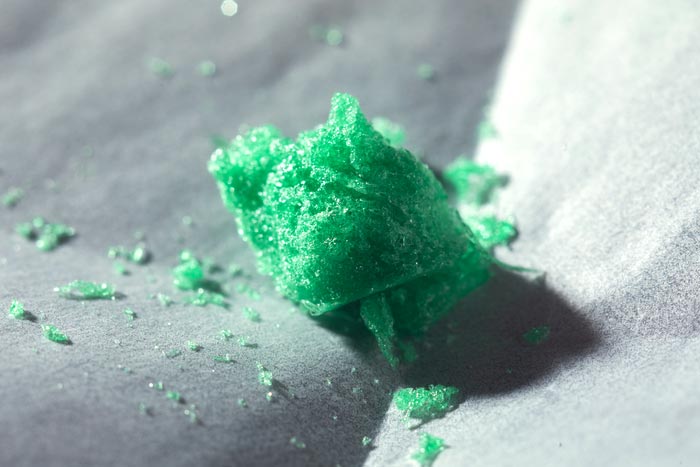How to freeze-dry a potential COVID-19 vaccine

The freeze-dried ingredients of a liposome-based vaccine that could be developed for COVID-19.
Credit: Douglas Levere / University at Buffalo
In Science Advances, scientists report successfully freeze-drying specialized liposomes that could be developed for use in future vaccines.
Things that are freeze-dried: Astronaut food. Emergency rations. And, just maybe, some future COVID-19 vaccines.
Freeze-drying is a method for removing water from a product. First, you freeze the item you’re trying to dehydrate, causing any water in it to become ice. Then, you remove the ice through a process called sublimation, in which ice turns directly into vapor under low pressure.
In a new study, scientists report that they have successfully freeze-dried a liposome-based liquid vaccine formula that could be developed for potential use in COVID-19 vaccines.
A vaccine that employs the freeze-dried liposomes is still a long way off. But if developed successfully, dehydrated doses could be shipped and stored at room temperature, eliminating logistical problems associated with some of the most popular existing vaccines for the disease.
The findings will be published in Science Advances on Dec. 1, with University at Buffalo biomedical engineering researchers Jonathan Lovell and Moustafa Mabrouk as the senior and first authors, respectively.
“At the time we started this project, the first COVID-19 vaccines were just getting rolled out, and there was a lot of news about how they needed ultra-cold storage, and how that was a huge logistical challenge. Especially in low- and middle-income countries, it may not always be feasible to have that type of refrigeration infrastructure. So we started to look at whether we could make a thermostable COVID-19 vaccine using a liposome-based vaccine platform that we worked on previously,” says Lovell, PhD, SUNY Empire Innovation Associate Professor in the Department of Biomedical Engineering in the UB School of Engineering and Applied Sciences and the Jacobs School of Medicine and Biomedical Sciences at UB.
The new study focuses on a liquid injection that consists of ingredients including water; specialized liposomes carrying a synthetically produced version of the spike protein of the COVID-19 virus; and a small amount of sugar, which helps to protect the formula during the freeze-drying process.
The freeze-dried product looks a bit like cotton candy, mint green in color.
“Upon dehydration, the formula was stable at elevated temperatures, and we showed that it can withstand room temperatures and even higher temperatures for at least a week,” says Mabrouk, a UB biomedical engineering PhD student. “After that, we reconstituted the formula by adding water. When we tested this in mice, it induced effective antibody responses and offered protection against the COVID-19 virus.”
Co-authors also include Wei-Chiao Huang and Breandan Quinn at UB; Kevin Chiem and Luis Martinez-Sobrido at the Texas Biomedical Research Institute in the U.S.; Edurne Rujas at The Hospital for Sick Children Research Institute in Canada and University of the Basque Country in Spain; Dushyant Jahagirdar and Joaquin Ortega at McGill University in Canada; Meera Surendran Nair, Ruth H. Nissly, Victoria S. Cavener, Nina R. Boyle, Ty A. Sornberger and Suresh V. Kuchipudi at Pennsylvania State University in the U.S.; and Jean-Philippe Julien at The Hospital for Sick Children Research Institute and University of Toronto in Canada.
The research was supported by the U.S. National Institutes of Health, the European Union’s Horizon 2020 research and innovation program under a Marie Sklodowska-Curie grant, the CIFAR Azrieli Global Scholar Program, the Ontario Early Researcher Awards program, and the Canada Research Chairs program.
The specialized liposomes examined in the Science Advances study are being researched for potential use in vaccines against multiple diseases. The liposomes were originally developed in Lovell’s UB lab and have been licensed by the university to POP Biotechnologies, a startup company that Lovell co-founded. (Huang is also a POP Biotechnologies employee.)
A COVID-19 vaccine candidate that relies on POP Biotechnologies’ liposome-based vaccine delivery system is in human trials in South Korea. That vaccine candidate, called EuCorVac-19, is under development by POP Biotechnologies and South Korean biotech company EuBiologics. EuCorVac-19 has slightly different ingredients from the vaccine formula studied in the Science Advances paper.
“We have not tested freeze-drying on the EuCorVac-19 vaccine,” Lovell says. “However, I think the data in this new study suggest that, in theory, the EuCorVac-19 formula may be amenable to this type of treatment to make it very thermostable, which would benefit any global deployment.”
Journal: Science Advances
DOI: 10.1126/sciadv.abj1476
Article Title: Lyophilized, thermostable Spike or RBD immunogenic liposomes induce protective immunity against SARS-CoV-2 in mice
Article Publication Date: 1-Dec-2021
COI Statement: Competing interests: Co-authors Jonathan Lovell and Wei-Chiao Huang hold interest in POP Biotechnologies. Wei-Chiao Huang is an employee of POP Biotechnologies.
Media Contact
Charlotte Hsu
University at Buffalo
chsu22@buffalo.edu
Office: 716-645-4655
All latest news from the category: Life Sciences and Chemistry
Articles and reports from the Life Sciences and chemistry area deal with applied and basic research into modern biology, chemistry and human medicine.
Valuable information can be found on a range of life sciences fields including bacteriology, biochemistry, bionics, bioinformatics, biophysics, biotechnology, genetics, geobotany, human biology, marine biology, microbiology, molecular biology, cellular biology, zoology, bioinorganic chemistry, microchemistry and environmental chemistry.
Newest articles

Properties of new materials for microchips
… can now be measured well. Reseachers of Delft University of Technology demonstrated measuring performance properties of ultrathin silicon membranes. Making ever smaller and more powerful chips requires new ultrathin…

Floating solar’s potential
… to support sustainable development by addressing climate, water, and energy goals holistically. A new study published this week in Nature Energy raises the potential for floating solar photovoltaics (FPV)…

Skyrmions move at record speeds
… a step towards the computing of the future. An international research team led by scientists from the CNRS1 has discovered that the magnetic nanobubbles2 known as skyrmions can be…





















